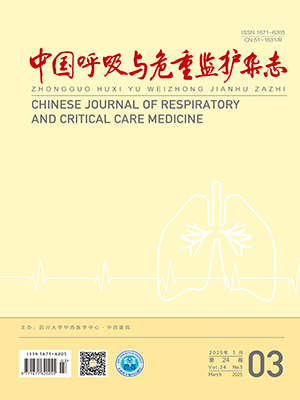| 1. |
Cabrini L, Landoni G, Oriani A, et al. Noninvasive ventilation and survival in acute care settings: a comprehensive systematic review and metaanalysis of randomized controlled trials. Crit Care Med, 2015, 43(4): 880-888.
|
| 2. |
中华医学会重症医学分会. 慢性阻塞性肺疾病急性加重患者的机械通气指南(2007), 中国危重病急救医学, 2007, 19(9): 513-518.
|
| 3. |
Rochwerg B, Brochard L, Elliott MW, et al. Official ERS/ATS clinical practice guidelines: noninvasive ventilation for acute respiratory failure. Eur Respir J, 2017, 50(2): 1602426.
|
| 4. |
Windisch W, Geiseler J, Simon K, et al. German National Guideline for Treating Chronic Respiratory Failure with Invasive and Non-Invasive Ventilation: Revised Edition 2017 - Part 1. Respiration, 2018, 96(1): 66-97.
|
| 5. |
Windisch W, Geiseler J, Simon K, et al. German National Guideline for Treating Chronic Respiratory Failure with Invasive and Non-Invasive Ventilation - Revised Edition 2017: Part 2. Respiration, 2018, 96(2): 171-203.
|
| 6. |
Luján M, Peñuelas Ó, Cinesi Gómez C, et al. Summary of recommendations and key points of the consensus of Spanish scientific societies (SEPAR, SEMICYUC, SEMES; SECIP, SENEO, SEDAR, SENP) on the use of non-invasive ventilation and high-flow oxygen therapy with nasal cannulas in adult, pediatric, and neonatal patients with severe acute respiratory failure. Med Intensiva (Engl Ed), 2021, 45(5): 298-312.
|
| 7. |
Martin-Gonzalez F, Gonzalez-Robledo J, Sanchez-Hernandez F, et al. Effectiveness and predictors of failure of noninvasive mechanical ventilation in acute respiratory failure. Med Intensiva, 2016, 40(1): 9-17.
|
| 8. |
Zhang ZL, Duan J. Nosocomial pneumonia in non-invasive ventilation patients: Incidence, characteristics, and outcomes. J Hosp Infect, 2015, 91(2): 153-157.
|
| 9. |
Fan LP, Zhao QH, Liu YC, et al. Semiquantitative cough strength score and associated outcomes in noninvasive positive pressure ventilation patients with acute exacerbation of chronic obstructive pulmonary disease. Respir Med, 2014, 108(12): 1801-1807.
|
| 10. |
Stefan MS, Nathanson BH, Higgins TL, et al. Comparative effectiveness of noninvasive and invasive ventilation in critically ill patients with acute exacerbation of chronic obstructive pulmonary disease. Crit Care Med, 2015, 43(7): 1386-1394.
|
| 11. |
Esteban A, Frutos-Vivar F, Ferguson ND, et al. Noninvasive positive-pressure ventilation for respiratory failure after extubation. N Engl J Med, 2004, 350(24): 2452-2460.
|
| 12. |
Kikuchi T, Toba S, Sekiguchi Y, et al. Protocol-based noninvasive positive pressure ventilation for acute respiratory failure. J Anesth, 2011, 25(1): 42-49.
|
| 13. |
Yoshida Y, Takeda S, Akada S, et al. Factors predicting successful noninvasive ventilation in acute lung injury. J Anesth, 2008, 22(3): 201-206.
|
| 14. |
Carron M, Freo U, Zorzi M, et al. Predictors of failure of noninvasive ventilation in patients with severe community-acquired pneumonia. J Crit Care, 2010, 25(3): 540. e9-14.
|
| 15. |
Carrillo A, Gonzalez-Diaz G, Ferrer M, et al. Non-invasive ventilation in community-acquired pneumonia and severe acute respiratory failure. Intensive Care Med, 2012, 38(3): 458-466.
|
| 16. |
Antonelli M, Conti G, Esquinas A, et al. A multiple-center survey on the use in clinical practice of noninvasive ventilation as a first-line intervention for acute respiratory distress syndrome. Crit Care Med, 2007, 35(1): 18-25.
|
| 17. |
Duan J, Han XL, Bai LF, et al. Assessment of heart rate, acidosis, consciousness, oxygenation, and respiratory rate to predict noninvasive ventilation failure in hypoxemic patients. Intensive Care Med, 2017, 43(2): 192-199.
|
| 18. |
Duan J, Chen LJ, Liu XY, et al. An updated HACOR score for predicting the failure of noninvasive ventilation: a multicenter prospective observational study. Crit Care, 2022, 26(1): 196.
|
| 19. |
Grieco DL, Menga LS, Eleuteri D, et al. Patient self-inflicted lung injury: implications for acute hypoxemic respiratory failure and ARDS patients on non-invasive support. Minerva Anestesiol, 2019, 85(9): 1014-1023.
|
| 20. |
Tonelli R, Fantini R, Tabbì L, et al. Early inspiratory effort assessment by esophageal manometry predicts noninvasive ventilation outcome in de novo respiratory failure. A pilot study. Am J Respir Crit Care Med, 2020, 202(4): 558-567.
|
| 21. |
Carteaux G, Millán-Guilarte T, De Prost N, et al. Failure of noninvasive ventilation for De Novo acute hypoxemic respiratory failure: role of tidal volume. Crit Care Med, 2016, 44(2): 282-290.
|
| 22. |
Chen DY, Heunks L, Pan C, et al. A novel index to predict the failure of high-flow nasal cannula in patients with acute hypoxemic respiratory failure: a pilot study. Am J Respir Crit Care Med, 2022, 206(7): 910-913.
|
| 23. |
Brochard L. Ventilation-induced lung injury exists in spontaneously breathing patients with acute respiratory failure: Yes. Intensive Care Med, 2017, 43(2): 250-252.
|
| 24. |
Yoshida T, Torsani V, Gomes S, et al. Spontaneous effort causes occult pendelluft during mechanical ventilation. Am J Respir Crit Care Med, 2013, 188(12): 1420-1427.
|
| 25. |
Ranieri VM, Rubenfeld GD, Thompson BT, et al. Acute respiratory distress syndrome: the Berlin Definition. JAMA, 2012, 307(23): 2526-2533.
|
| 26. |
Brochard L, Lefebvre JC, Cordioli RL, et al. Noninvasive ventilation for patients with hypoxemic acute respiratory failure. Semin Respir Crit Care Med, 2014, 35(4): 492-500.
|
| 27. |
Mosier JM, Sakles JC, Whitmore SP, et al. Failed noninvasive positive-pressure ventilation is associated with an increased risk of intubation-related complications. Ann Intensive Care, 2015, 5: 4.
|
| 28. |
Demoule A, Chevret S, Carlucci A, et al. Changing use of noninvasive ventilation in critically ill patients: trends over 15 years in francophone countries. Intensive Care Med, 2016, 42(1): 82-92.
|




